Development of Water-in-Oil Emulsions as Delivery Vehicles and Testing with a Natural Antimicrobial Extract
Abstract
1. Introduction
2. Results and Discussion
2.1. Systematic Study and Base Emulsion Selection
2.1.1. Analysis at the Microscopic Level
2.1.2. Analysis at the Macroscopic Level
2.1.3. Base Emulsion Selection
2.2. Cinnamon Extract Loaded Emulsions
2.2.1. Droplet Size Range of Loaded Emulsions
2.2.2. Confocal Microscopy Analysis
2.2.3. Antimicrobial Analysis
2.2.4. Antioxidant Analysis
2.2.5. Stability Tests
3. Materials and Methods
3.1. Materials
3.2. Emulsions Preparation
3.3. Optical Microscopy Analysis
3.4. Visual Analysis
3.5. Confocal Microscopy Analysis
3.6. Antimicrobial Assays
3.7. Antioxidant Assay
3.8. Stability Tests
4. Conclusions
Supplementary Materials
Author Contributions
Funding
Conflicts of Interest
References
- Schramm, L.L. Emulsions, Foams, and Suspensions: Fundamentals and Applications, 1st ed.; John Wiley & Sons, Inc.: Hoboken, NJ, USA, 2005; pp. 1–13. [Google Scholar]
- Kale, S.N.; Deore, S.L. Emulsion Micro Emulsion and Nano Emulsion: A Review. Syst. Rev. Pharm. 2017, 8, 39–47. [Google Scholar] [CrossRef]
- Ito, M.; Uehara, M.; Wakui, R.; Shiota, M.; Kuroiwa, T. Preparation Characteristics of Water-in-oil Emulsion Using Olive Oil as a Continuous Phase in Microchannel Emulsification. Jpn. J. Food Eng. 2017, 18, 103–111. [Google Scholar] [CrossRef]
- Çinar, K. A Review on Nanoemulsions: Preparation Methods and Stability. Trak. Univ. J. Eng. Sci. 2017, 18, 73–83. [Google Scholar]
- Cheng, C.J.; Chu, L.Y.; Xie, R. Preparation of highly monodisperse W/O emulsions with hydrophobically modified SPG membranes. J. Colloid Interface Sci. 2006, 300, 375–382. [Google Scholar] [CrossRef] [PubMed]
- Kiefer, J.; Frank, K.; Zehentbauer, F.M.; Schuchmann, H.P. Infrared spectroscopy of bilberry extract water-in-oil emulsions: Sensing theWater-Oil Interface. Biosensors 2016, 6, 13. [Google Scholar] [CrossRef] [PubMed]
- Wu, H.; Ramachandran, C.; Weiner, N.D.; Roessler, B.J. Topical transport of hydrophilic compounds using water-in-oil nanoemulsions. Int. J. Pharm. 2001, 220, 63–75. [Google Scholar] [CrossRef]
- Zhu, Q.; Pan, Y.; Jia, X.; Li, J.; Zhang, M.; Yin, L. Review on the Stability Mechanism and Application of Water-in-Oil Emulsions Encapsulating Various Additives. Compr. Rev. Food Sci. Food Saf. 2019, 18, 1660–1675. [Google Scholar] [CrossRef]
- Wang, L.Y.; Ma, G.H.; Su, Z.G. Preparation of uniform sized chitosan microspheres by membrane emulsification technique and application as a carrier of protein drug. J. Control. Release 2005, 106, 62–75. [Google Scholar] [CrossRef]
- Ismail, I.; Kazemzadeh, Y.; Sharifi, M.; Riazi, M.; Malayeri, M.R.; Cortés, F. Formation and stability of W/O emulsions in presence of asphaltene at reservoir thermodynamic conditions. J. Mol. Liq. 2020, 299, 112–125. [Google Scholar] [CrossRef]
- Goodarzi, F.; Zendehboudi, S. A Comprehensive Review on Emulsions and Emulsion Stability in Chemical and Energy Industries. Can. J. Chem. Eng. 2019, 97, 281–309. [Google Scholar] [CrossRef]
- Tabibiazar, M.; Hamishehkar, H. Formulation of a Food Grade Water-In-Oil Nanoemulsion: Factors Affecting on Stability. Pharm. Sci. 2015, 21, 220–224. [Google Scholar] [CrossRef]
- Salager, J.-L. Formulation Concepts for the Emulsion Maker. In Pharmaceutical Emulsions and Suspensions, 1st ed.; Nielloud, F., Marti-Mestres, G., Eds.; Marcel Dekker, Inc.: New York, NY, USA, 2000; pp. 19–72. [Google Scholar]
- Claesson, P.M.; Blomberg, E.; Poptoshev, E. Surfaces Forces and Emulsion Stability. In Food Emulsions, 4th ed.; Friberg, S.E., Larsson, K., Sjöblom, J., Eds.; Marcel Dekker, Inc.: New York, NY, USA, 2004; Chapter 7 (e-book version). [Google Scholar]
- Ushikubo, F.Y.; Cunha, R.L. Stability mechanisms of liquid water-in-oil emulsions. Food Hydrocoll. 2014, 34, 145–153. [Google Scholar] [CrossRef]
- Márquez, A.L.; Medrano, A.; Panizzolo, L.A.; Wagner, J.R. Effect of calcium salts and surfactant concentration on the stability of water-in-oil (w/o) emulsions prepared with polyglycerol polyricinoleate. J. Colloid Interface Sci. 2010, 341, 101–108. [Google Scholar] [CrossRef] [PubMed]
- Yi, J.; Zhu, Z.; McClements, D.J.; Decker, E.A. Influence of aqueous phase emulsifiers on lipid oxidation in water-in-walnut oil emulsions. J. Agric. Food Chem. 2014, 62, 2104–2111. [Google Scholar] [CrossRef]
- Ahmad, Z. The uses and properties of almond oil. Complement. Ther. Clin. Pract. 2010, 16, 10–12. [Google Scholar] [CrossRef]
- Nabavi, S.F.; Di Lorenzo, A.; Izadi, M.; Sobarzo-Sánchez, E.; Daglia, M.; Nabavi, S.M. Antibacterial effects of cinnamon: From farm to food, cosmetic and pharmaceutical industries. Nutrients 2015, 7, 7729–7748. [Google Scholar] [CrossRef]
- Ribeiro-Santos, R.; Andrade, M.; Madella, D.; Martinazzo, A.P.; Moura, L.A.G.; Melo, N.R.; Sanches-Silva, A. Revisiting an ancient spice with medicinal purposes: Cinnamon. Trends Food Sci. Technol. 2017, 62, 154–169. [Google Scholar] [CrossRef]
- Ranasinghe, P.; Pigera, S.; Premakumara, G.S.; Galappaththy, P.; Constantine, G.R.; Katulanda, P. Medicinal properties of “true” cinnamon (Cinnamomum zeylanicum): A systematic review. BMC Complement. Altern. Med. 2013, 13, 275. [Google Scholar] [CrossRef]
- Bokhout, B.A.; Van Gaalen, C.; Van der Heijden, P.J. A selected water-in-oil emulsion: Composition and usefulness as an immunological adjuvant. Vet. Immunol. Immunopathol. 1981, 2, 491–500. [Google Scholar] [CrossRef]
- Opawale, F.O.; Burgess, D.J. Influence of interfacial properties of lipophilic surfactants on water-in-oil emulsion stability. J. Colloid Interface Sci. 1998, 197, 142–150. [Google Scholar] [CrossRef]
- Lee, L.; Hancocks, R.; Noble, I.; Norton, I.T. Production of water-in-oil nanoemulsions using high pressure homogenisation: A study on droplet break-up. J. Food Eng. 2014, 131, 33–37. [Google Scholar] [CrossRef]
- McClements, D.J. Food Emulsions: Principles, Practices, and Techniques, 3rd ed.; CRC Press: New York, NY, USA, 2015. [Google Scholar]
- Hu, Y.T.; Ting, Y.; Hu, J.Y.; Hsieh, S.C. Techniques and methods to study functional characteristics of emulsion systems. J. Food Drug Anal. 2017, 25, 16–26. [Google Scholar] [CrossRef] [PubMed]
- Moschakis, T.; Murray, B.S.; Dickinson, E. Microstructural evolution of viscoelastic emulsions stabilised by sodium caseinate and xanthan gum. J. Colloid Interface Sci. 2005, 284, 714–728. [Google Scholar] [CrossRef] [PubMed]
- Reis, A.C.P.A. Contributions to the development of phage therapies or multi-resistant Pseudomonas aeruginosa nosocomial infections. Master’s Thesis, Polytechnic Institute of Porto, Porto, Portugal, 2011. [Google Scholar]
- ASTM E2149-13a. Standard Test Method for Determining the Antimicrobial Activity of Antimicrobial Agents Under Dynamic Contact Conditions; ASTM International: West Conshohocken, PA, USA, 2013; Available online: www.astm.org (accessed on 20 June 2019).
- Hudzicki, J. Kirby-Bauer Disk Diffusion Susceptibility Test Protocol. Am. Soc. Microbiol. 2009, 1–13. Available online: https://www.asm.org/Protocols/Kirby-Bauer-Disk-Diffusion-Susceptibility-Test-Pro (accessed on 18 May 2019).
- Lv, X.; Cong, Z.; Liu, Z.; Ma, X.; Xu, M.; Tian, Y.; Zhang, X.; Xu, B.; Zhang, J.; Tang, Z. Improvement of the solubility, photostability, antioxidant activity and UVB photoprotection of trans-resveratrol by essential oil based microemulsions for topical application. J. Drug Deliv. Sci. Technol. 2018, 48, 346–354. [Google Scholar] [CrossRef]
- Sarmento, A.; Barros, L.; Fernandes, Â.; Carvalho, A.M.; Ferreira, I.C.F.R. Valorization of traditional foods: Nutritional and bioactive properties of Cicer arietinum L. and Lathyrus sativus L. Pulses. J. Sci. Food. Agric. 2015, 95, 179–185. [Google Scholar] [CrossRef]
- Bernardi, D.S.; Pereira, T.A.; Maciel, N.R.; Bortoloto, J.; Viera, G.S.; Oliveira, G.C.; Rocha-Filho, P.A. Formation and stability of oil-in-water nanoemulsions containing rice bran oil: In vitro and in vivo assessments. J. Nanobiotechnol. 2011, 9, 44. [Google Scholar] [CrossRef]
- Ribeiro, R.C.D.A.; Barreto, S.M.A.G.; Ostrosky, E.A.; Da Rocha-Filho, P.A.; Veríssimo, L.M.; Ferrari, M. Production and characterization of cosmetic nanoemulsions containing Opuntia ficus-indica (L.) Mill extract as moisturizing agent. Molecules 2015, 20, 2492–2509. [Google Scholar] [CrossRef]
Sample Availability: Samples not available from the authors. |
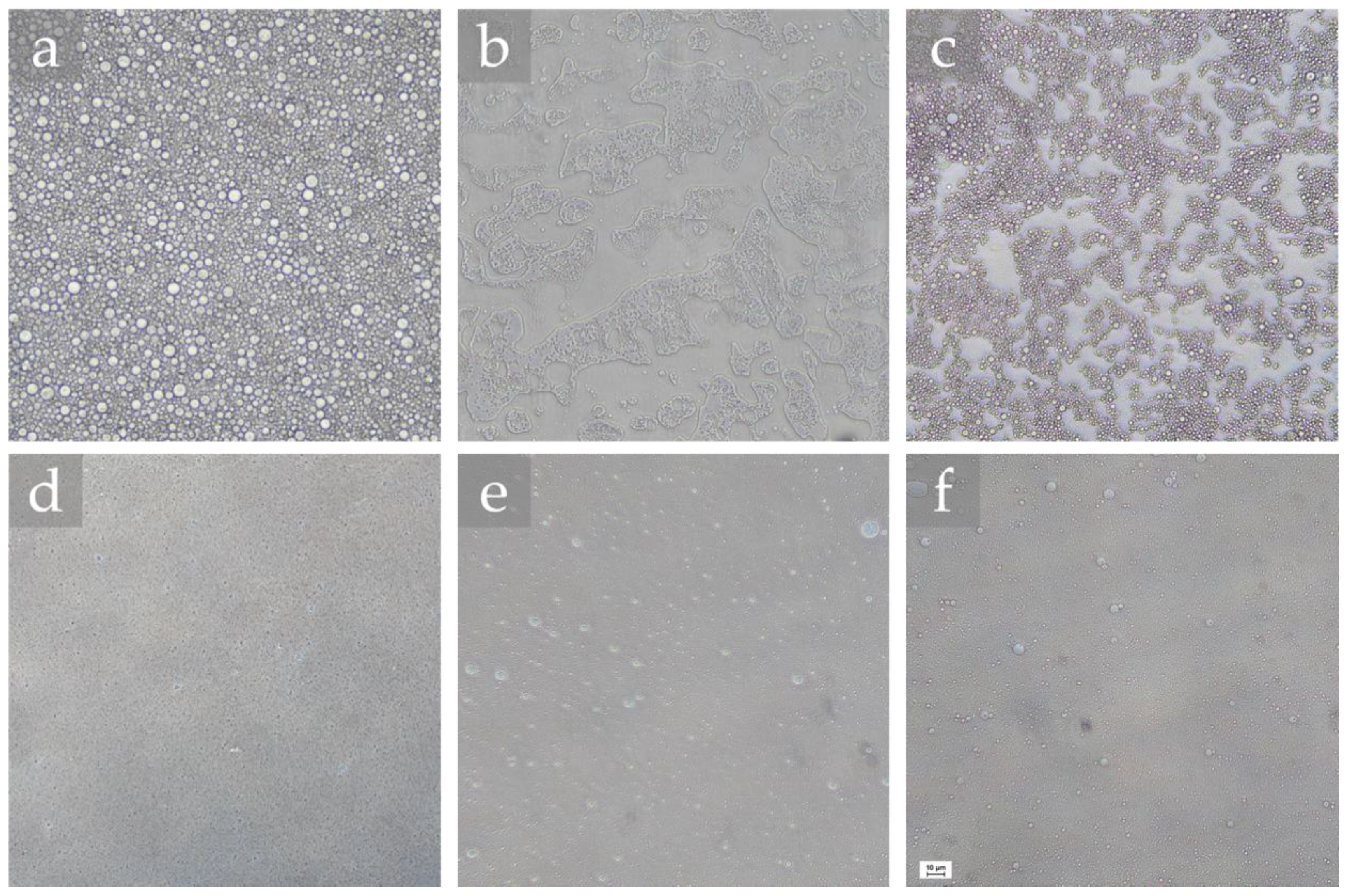
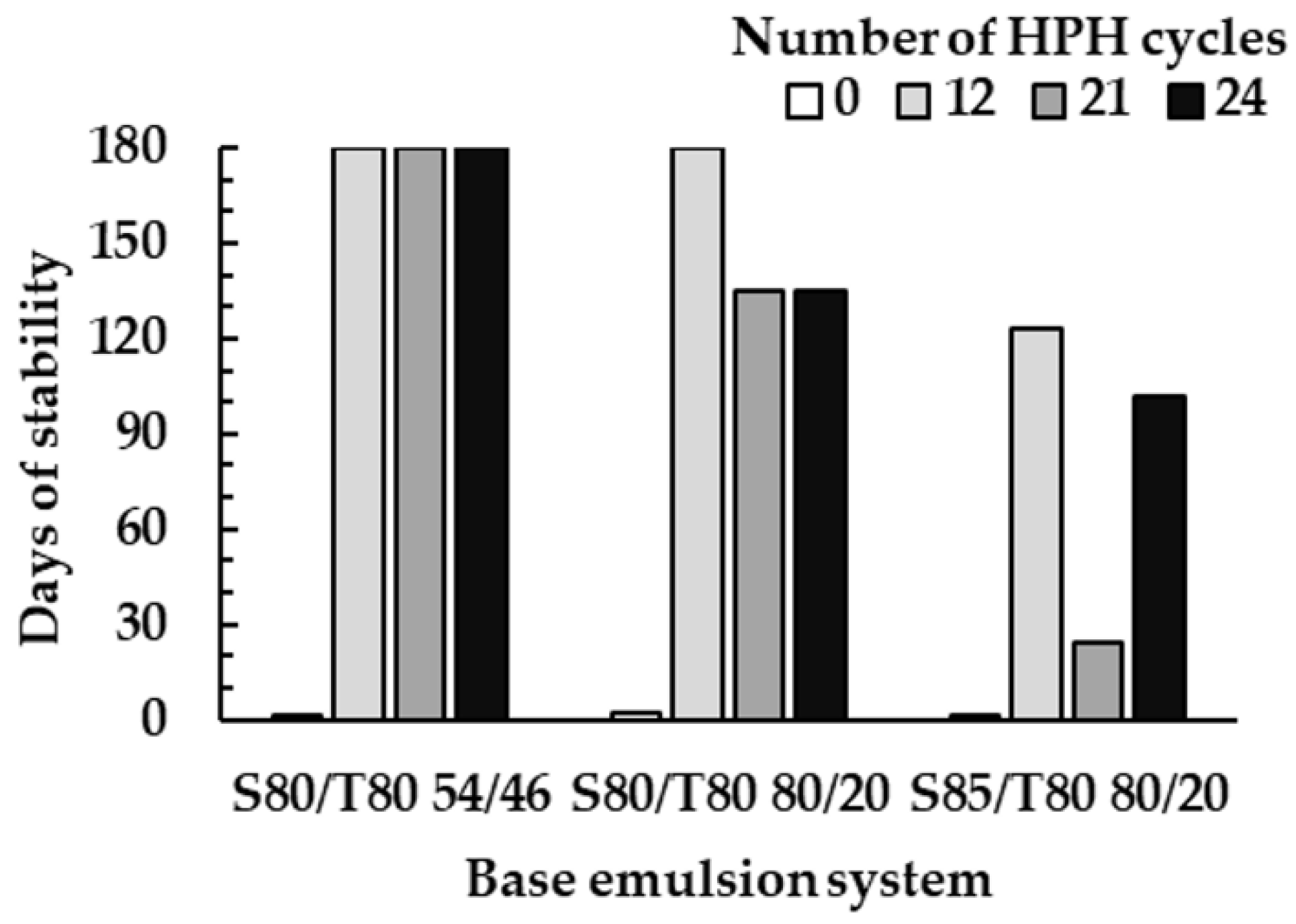
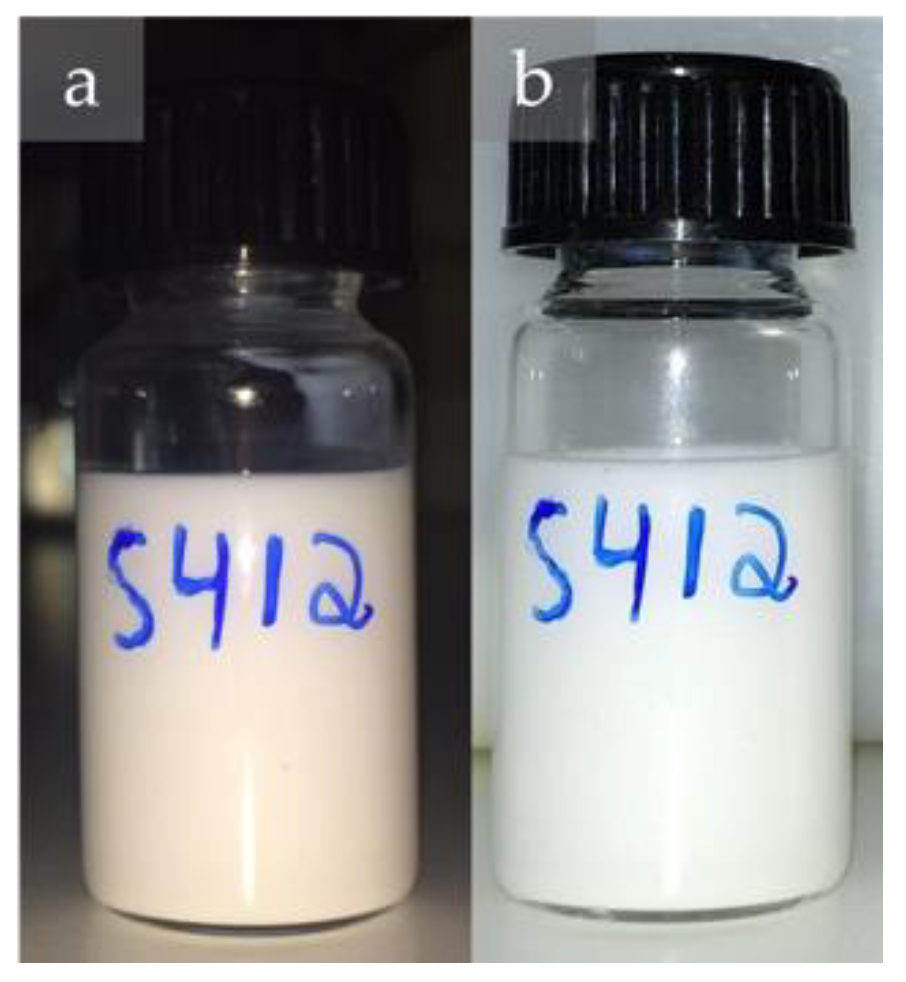

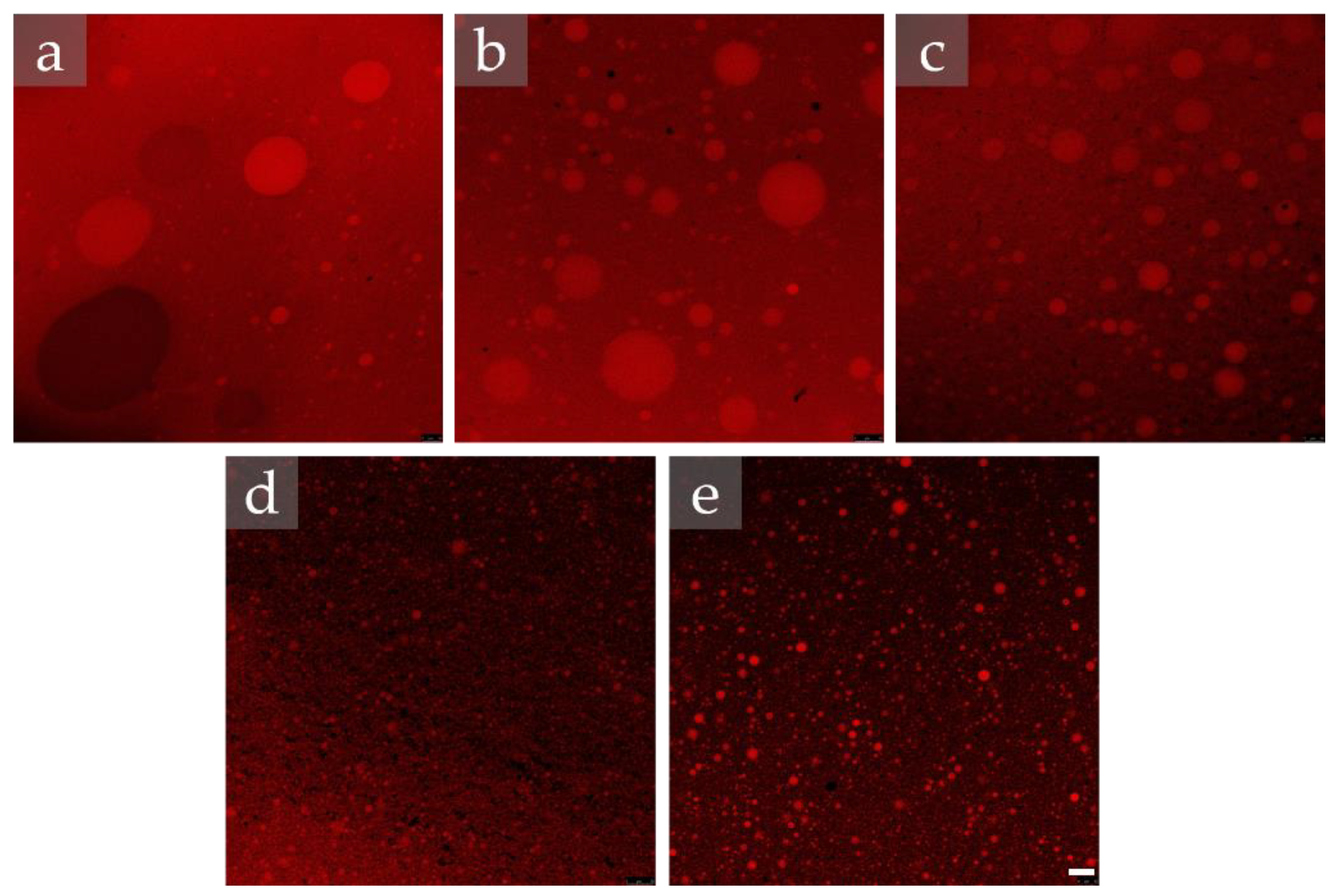
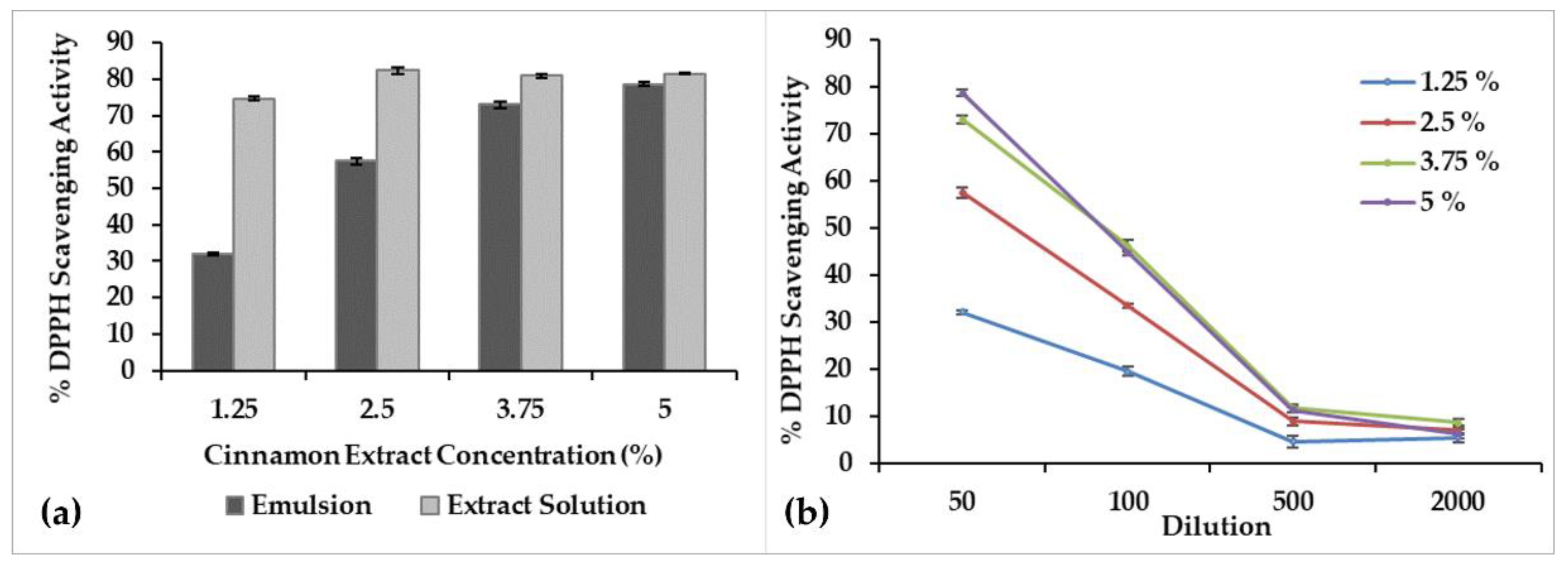
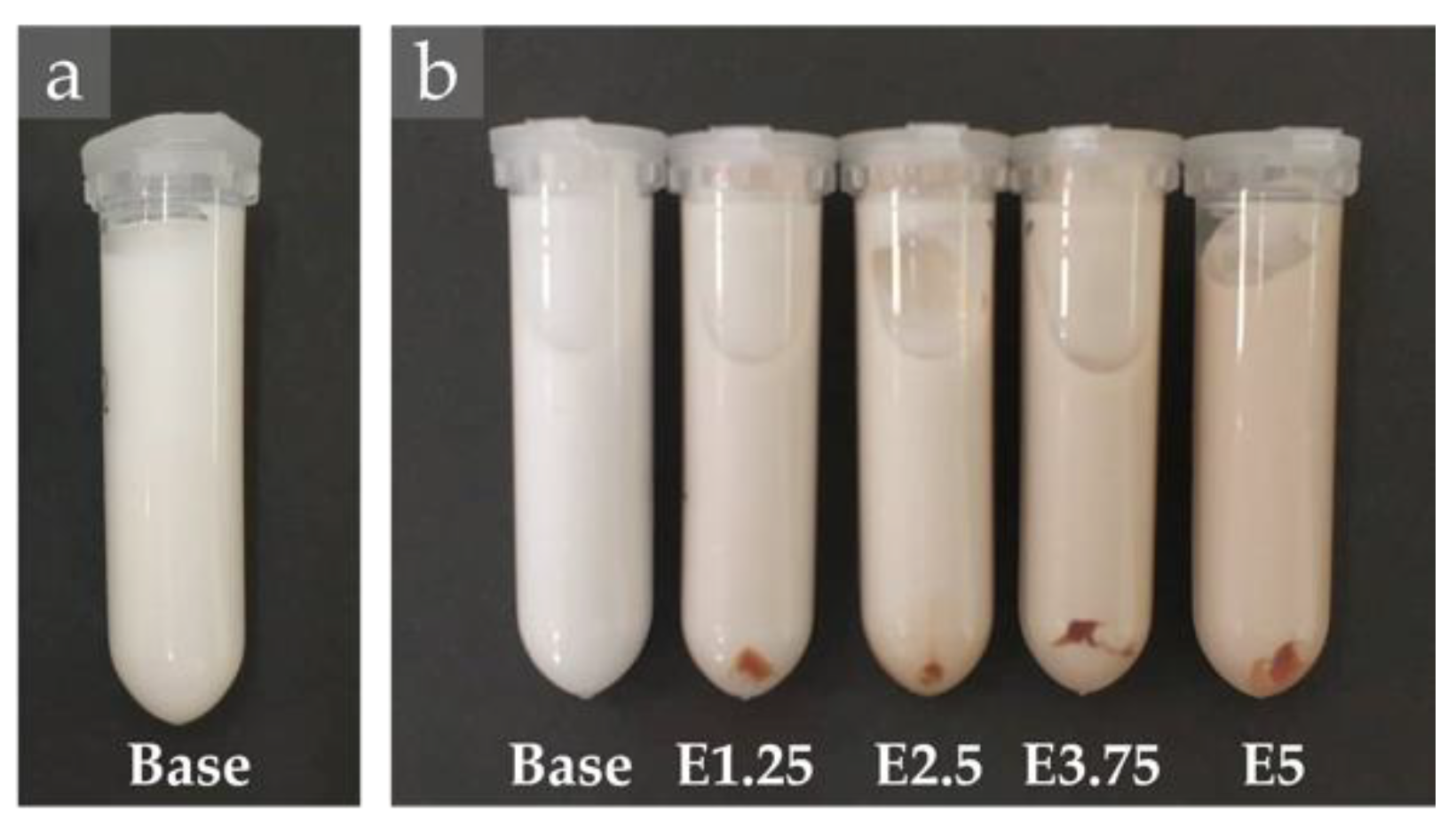
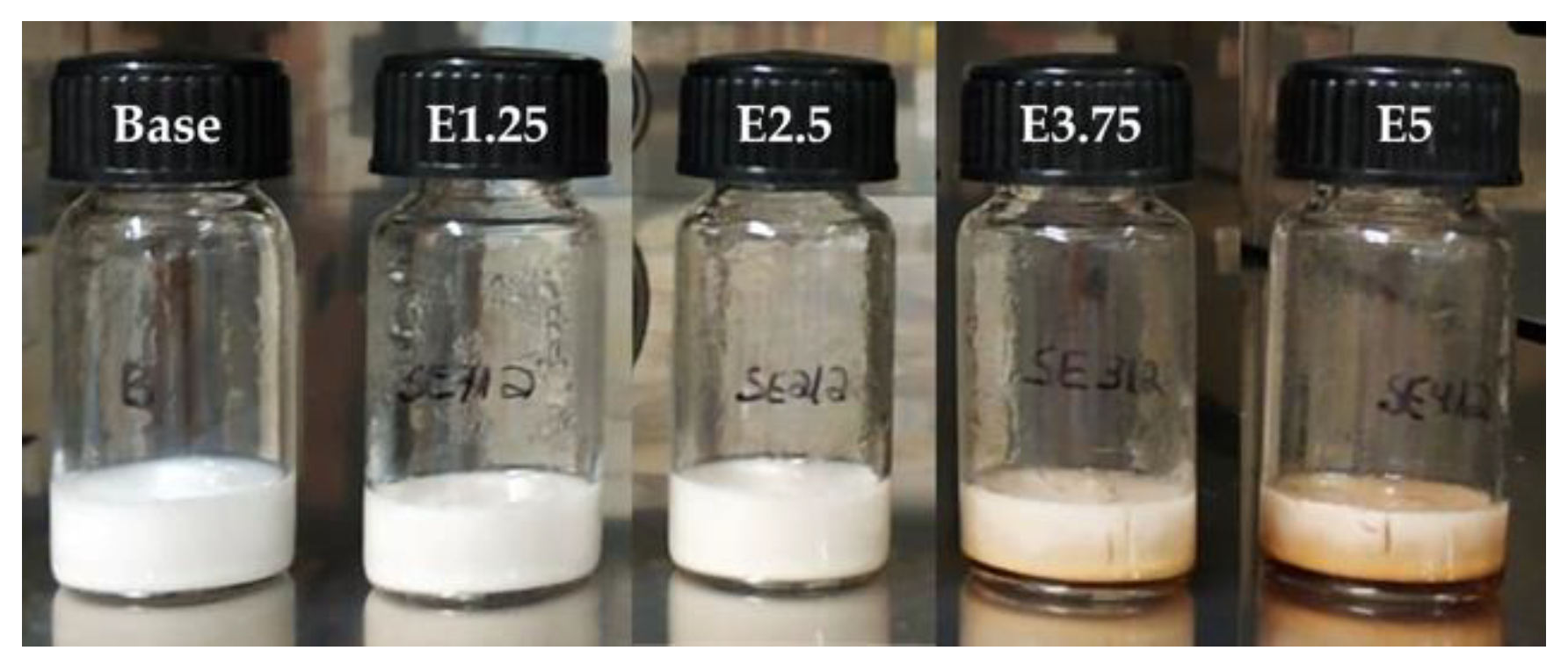
| Base Emulsion | Droplet Size (μm) | |||
|---|---|---|---|---|
| Primary Emulsion | 12 Cycles | 21 Cycles | 24 Cycles | |
| S80/T80 54/46 | 3.5–7.1 | ND | ND | 0.5–1.4 |
| S80/T80 80/20 | 0.5–1.1 | 0.4–1.0 | ND | ND |
| S85/T80 80/20 | 0.7–1.7 | 0.6–1.2 | 0.2–0.7 | ND |
| Sample | Cinnamon Content (%, w/v) | Droplet Size (μm) | |
|---|---|---|---|
| Primary Emulsion | 12 Cycles | ||
| Base Emulsion | 0 | 3.5–7.1 | ND |
| E1.25 | 1.25 | 1.0–15.4 | 0.8–1.4 |
| E2.5 | 2.50 | 1.5–10.0 | 0.8–2.0 |
| E3.75 | 3.75 | 1.0–14.8 | 0.7–1.3 |
| E5 | 5.00 | 1.0–11.3 | 0.6–1.6 |
| Sample | % Cinnamon (w/v) | Inhibition Zone 1 (mm) | |||||
|---|---|---|---|---|---|---|---|
| After 24 h | After 96 h | ||||||
| S. aureus | E. coli | P. aeruginosa | S. aureus | E. coli | P. aeruginosa | ||
| Base Emulsion | 0 | - | - | - | - | - | - |
| E1.25 | 1.25 | 9 | - | - | 9 | 9 | - |
| E2.5 | 2.5 | 9 | - | - | 9 | 9 | - |
| E3.75 | 3.75 | 9 | - | - | 9 | 9 | - |
| E5 | 5 | 9 | - | - | 9 | 9 | - |
| AE1.25 | 1.25 | 10 | - | - | 9 | 9 | - |
| AE2.5 | 2.5 | 10 | - | - | 9 | 9 | - |
| AE3.75 | 3.75 | 10 | - | - | 10 | 9 | - |
| AE5 | 5 | 14 | 7 | - | 12 | 9 | - |
| Kanamycin | 0 | 30 | 30 | 15 | 30 | 32 | 35 |
| Sweet Almond Oil | 0 | - | - | - | - | - | - |
| Emulsifier mixture | 0 | - | - | - | - | - | - |
© 2020 by the authors. Licensee MDPI, Basel, Switzerland. This article is an open access article distributed under the terms and conditions of the Creative Commons Attribution (CC BY) license (http://creativecommons.org/licenses/by/4.0/).
Share and Cite
Colucci, G.; Santamaria-Echart, A.; Silva, S.C.; Fernandes, I.P.M.; Sipoli, C.C.; Barreiro, M.F. Development of Water-in-Oil Emulsions as Delivery Vehicles and Testing with a Natural Antimicrobial Extract. Molecules 2020, 25, 2105. https://doi.org/10.3390/molecules25092105
Colucci G, Santamaria-Echart A, Silva SC, Fernandes IPM, Sipoli CC, Barreiro MF. Development of Water-in-Oil Emulsions as Delivery Vehicles and Testing with a Natural Antimicrobial Extract. Molecules. 2020; 25(9):2105. https://doi.org/10.3390/molecules25092105
Chicago/Turabian StyleColucci, Giovana, Arantzazu Santamaria-Echart, Samara C. Silva, Isabel P. M. Fernandes, Caroline C. Sipoli, and Maria F. Barreiro. 2020. "Development of Water-in-Oil Emulsions as Delivery Vehicles and Testing with a Natural Antimicrobial Extract" Molecules 25, no. 9: 2105. https://doi.org/10.3390/molecules25092105
APA StyleColucci, G., Santamaria-Echart, A., Silva, S. C., Fernandes, I. P. M., Sipoli, C. C., & Barreiro, M. F. (2020). Development of Water-in-Oil Emulsions as Delivery Vehicles and Testing with a Natural Antimicrobial Extract. Molecules, 25(9), 2105. https://doi.org/10.3390/molecules25092105









